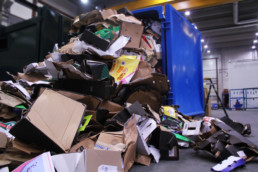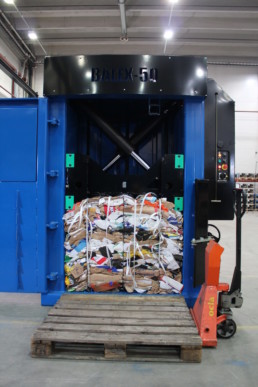Cardboard is highly recyclable. When collected correctly and it only has a small amount of dirty or unusable material, cardboard can be recycled almost endlessly. Cardboard waste will be shredded and turned into cardboard pulp that can then be formed into new cardboard.
Waste compactors
Waste compactors are a great way of collecting cardboard. A basic CombiMax waste compactor with a 20m3 container can store up to 3000 kg of compacted cardboard. Compared if you would store the same amount of cardboard in a 770-litre wheeled waste bin which has a maximum load capacity of 360kg, you would need more than 8 full waste bins. That is a huge waste of money and time. In this time, you would need to empty the compactor only once, but the less sufficient waste bin you would have to empty 8 times! A waste compactor will save time, money, and space. It will also keep the cardboard in one place and away from pests, but also clean and dry. Waste compactors can also be equipped with Europress SMART service which will tell you when the compactor is getting full so you can get even better use for your time and money. SMART service will save you time on emptying the compactor, so you don’t have to worry about it or have to pay for unnecessary emptying when the compactor has not been full.

Balex®-Balers
If you don’t have space for a waste compactor a Balex® Baler is a great option. Balex balers can fit conveniently in a waste room if space is tight. Balex balers come in 6 sizes and each of them are a great fit to a waste room. When the baler is full, the bale can be moved to a pallet for further processing. The most popular Balex-30 baler has 30 tons of compression force producing very dense 280–320 kg bales. This compared to a 770-litre wheeled waste bin having a maximum load capacity of 360kg and a 240-litre waste bin having a maximum load of 110kg, which is a huge difference. This means only one bale weights the same as a 770 litre wheelie bin full of uncompressed cardboard, which has to be emptied on the spot unlike the Balex Baler which you remove the bale from and can instantly put more material in.

Types of cardboard waste
There are two types of cardboard waste, corrugated cardboard and paperboard. Each time cardboard is recycled the fibers holding it together gets a bit shorter and when the fibers get too short to be recycled as corrugated cardboard the fibers can be recycled to paperboard material.
Examples of corrugated cardboard:
Shipping or packing boxes
Thicker product boxes
Examples of paperboard:
Product boxes like cereal boxes
Milk cartons
Paper products like tissues and napkins

